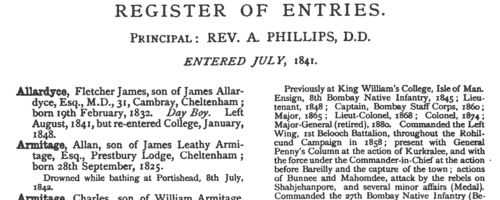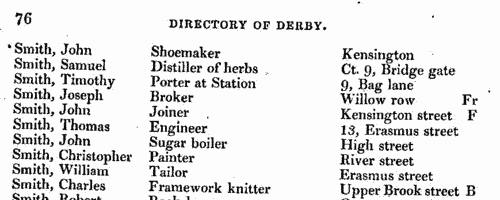Salt Surname Ancestry ResultsOur indexes 1000-1999 include entries for the spelling 'salt'. In the period you have requested, we have the following 608 records (displaying 281 to 290): Single Surname Subscription | | | Buying all 608 results of this search individually would cost £3,464.00. But you can have free access to all 608 records for a year, to view, to save and print, for £100. Save £3,364.00. More... |
These sample scans are from the original record. You will get scans of the full pages or articles where the surname you searched for has been found. Your web browser may prevent the sample windows from opening; in this case please change your browser settings to allow pop-up windows from this site. Insolvents
(1841)
Insolvency notices for England and Wales: insolvency often caused people to restart their lives elsewhere, so these are an important source for lost linksSALT. Cost: £6.00.  | Sample scan, click to enlarge

| Officers and officials of English hospitals
(1841)
The Royal Kalendar lists patrons, governors, officers and staff of the hospitals and infirmaries in and near London: Saint Bartholomew's; the Bridewell and Bethlem; St Thomas's; Emanuel; Asylum for Poor French Protestants; Westminster Hospital; Guy's; Bancroft's Hospital; St George's; the Foundling Hospital; the London Hospital; the Hospital for Casual Smallpox and Vaccination; Lock Hospital; Middlesex Hospital; the British Lying-in Hospital for Married Women; the City of London Lying-in Hospital; St Luke's Hospital for Lunatics; Queen Charlotte's Lying-in Hospital; the Asylum for French Orphans; the General Lying-in Hospital; the Jews Hospital; Seamen's Hospital Society; Magdalen Hospital; London Fever Hospital; Royal London Ophthalmic Hospital; Royal Sea Bathing Infirmary (at Westbrook near Margate); Royal Infirmary for Diseases of the Eye; Royal Westminster Ophthalmic Hospital; Infirmary for Asthma, Consumption and other Diseases of the Lungs; Charing Cross Hospital and Medical College; the Royal Metropolitan Hospital for Children; the Royal Maternity Charity for delivering Poor Married Women at their own Habitations; the General Dispensary for Relief of the Poor; Westminster General Dispensary; London Dispensary; Finsbury Dispensary; the Eastern Dispensary; the Public Dispensary; Marylebone General Dispensary; Queen Adelaide and British Ladies Lying-in Institution; the City Dispensary; the Western Dispensary; Surrey Dispensary; Tower Hamlets Dispensary; Bloomsbury Dispensary; the National Truss Society; the Rupture Society for the Supply of Trusses to the Indigent Poor; the City of London Truss Society; the National Vaccine Establishment; the Charitable Fund and Dispensary for Relieving the Sick Poor at their own Habitations with Medicines and Pecuniary Aid; the Northern Dispensary; the Royal Infirmary for Children; the Royal Dispensary for the Diseases of the Ear, and the Deaf and Dumb; the Royal Jennerian and London Vaccine Institution for the Extermination of Smallpox, for Gratuitous Vaccination, and Keeping up a Genuine Ichor; and St George's and St James's Dispensary.SALT. Cost: £6.00.  | Sample scan, click to enlarge

| Walsall Electors: Bridge Ward
(1841)
'A Correct Copy of the Poll taken at the late Election of a Member of Parliament, for the Borough of Walsall, in the County of Stafford, on Tuesday, the 2nd of February, 1841. Arranged so as to shew The Names of the several Polling Districts into which the Borough was divided; the Vote given by every person who did vote; and distinguishing those who did not vote. Candidates. John Neilson Gladstone, Esq. John Benjamin Smith, Esq.' The four polling districts were: 1 The Foreign Ward (exclusive of Bloxwich and neighbourhood; 2 Bloxwich and neighbourhood; 3 St George's Ward; 4 The Bridge Ward. The names are arranged by initial letter of surname, surname first, with nature of qualification (such as House; Warehouse; House and Land), where the qualifying property was situate; and whether a vote was cast for Gladstone or Smith.SALT. Cost: £4.00.  | Sample scan, click to enlarge

|  London Policemen
(1830-1842) London Policemen
(1830-1842)
The Metropolitan Police Register of Joiners (MEPO 333/4) lists policemen joining the force through to 31 December 1842 (to warrant number 19892). The register is alphabetical, in so far as the recruits are listed chronologically grouped under first letter of surname. It is evidently a continuation of a similar earlier register, not closed until its alphabetical sections were filled: consequently, there are no entries in this register for the initial letters N, O, Q, U, V, X, Y or Z; and the sections of this register start at different dates - A 18 April 1840 (warrant number 16894); B 11 December 1830 (5570); C 7 September 1830 (4988); D 27 May 1833 (8445); E 15 December 1838 (14476); F 30 March 1832 (7372); G 1 December 1835 (11,184); H 25 April 1832 (7457); I and J 13 February 1837 (12449); K 2 January 1838 (13457); L 3 October 1834 (9905); M 15 November 1832 (7999); P 4 October 1831 (6869); R 4 September 1837 (13021); S 30 March 1835 (10366); T 6 April 1840 (16829); W 30 December 1833 (9096). The register gives Date of Appointment, Name, Number of Warrant, Cause of Removal from Force (resigned, dismissed, promoted or died), and Date of Removal. Although the register was closed for new entrants at the end of 1842, the details of removals were always recorded, some being twenty or more years later. Those recruits not formerly in the police, the army, or some government department, were required to provide (normally) at least two letters of recommendation from persons of standing, and details of these are entered on the facing pages: the names in these are indexed separately - this index refers only to the police constables. Where a recruit was only recently arrived in the metropolis, the names and addresses of the recommenders can be invaluable for tracing where he came from.SALT. Cost: £8.00.  | Sample scan, click to enlarge

|  Persons of standing recommending London police recruits
(1830-1842) Persons of standing recommending London police recruits
(1830-1842)
The Metropolitan Police Register of Joiners (MEPO 333/4) lists policemen joining the force through to 31 December 1842 (to warrant number 19892). The register is alphabetical, in so far as the recruits are listed chronologically grouped under first letter of surname. It is evidently a continuation of a similar earlier register, not closed until its alphabetical sections were filled: consequently, there are no entries in this register for the initial letters N, O, Q, U, V, X, Y or Z; and the sections of this register start at different dates - A 18 April 1840 (warrant number 16894); B 11 December 1830 (5570); C 7 September 1830 (4988); D 27 May 1833 (8445); E 15 December 1838 (14476); F 30 March 1832 (7372); G 1 December 1835 (11,184); H 25 April 1832 (7457); I and J 13 February 1837 (12449); K 2 January 1838 (13457); L 3 October 1834 (9905); M 15 November 1832 (7999); P 4 October 1831 (6869); R 4 September 1837 (13021); S 30 March 1835 (10366); T 6 April 1840 (16829); W 30 December 1833 (9096). The register gives Date of Appointment, Name, Number of Warrant, Cause of Removal from Force (resigned, dismissed, promoted or died), and Date of Removal. Those recruits not formerly in the police, the army, or some government department, were required to provide (normally) at least two letters of recommendation from persons of standing, and details of these are entered on the facing pages: the names in these are indexed here (the police recruits are indexed separately and not included here). Recruits transferred from other forces or rejoining the force did not normally need recommendations - in the latter case, former warrant numbers are given - but some recommendations are from police inspectors, even other constables. Recruits coming from the army sometimes have general military certificates of good conduct, but most often have a letter from their former commanding officer; recruits recommended by government departments (most often the Home Office) similarly have letters from the head of department. But the great majority of the names and addresses in these pages are of respectable citizens having some sort of personal acquaintance with the recruit. Where more than two recommendations were provided, the clerk would only record one or two, with the words 'and others'. Tradesmen are sometimes identified as such by their occupations; there are some gentry. Although the great bulk of these names are from London and the home counties, a scattering are from further afield throughout Britain and Ireland. SALT. Cost: £8.00.  | Sample scan, click to enlarge

| Boys entering Cheltenham College
(1842)
Cheltenham College 'was founded in order to provide for the sons of gentlemen a Classical, Mathematical, and General Education of the highest order, on moderate terms, in strict conformity with the principles and doctrines of the Church of England.'
Andrew Alexander Hunter, the college registrar, compiled the first edition of the College Register in four parts from 1883 to 1886: these merely listed the boys by term of entry, with their dates of birth and names and addresses of their fathers. Circulars were also sent out to all Old Cheltonians whose addresses were known, requesting additional details. On the basis of the returns from these and Hunter's further researches, this much fuller register was published in 1890.
The information after each boy's name is given (where known and applicable) in this format: father's full name and address as of the time the boy entered the college; class and department on entering the college (classes being number from 1 downwards, and these again divided into A and B, some into C and D, others into P (Principal's side) and V. P. (Vice-Principal's side) - 1A was the highest class in each department: besides this, certain others were called Addiscombe, Woolwich, Civil, Direct, Line, Sandhurst, Naval, Special, Preparatory, Latin, and India Civil) and the same on leaving, name of Boarding House (or 'Day Boy'), scholastic and athletic honours attained at the college, and subsequent career (including date and place of death, or present address in 1890, if known).SALT. Cost: £4.00.  | Sample scan, click to enlarge

| Inhabitants of Derby
(1842)
Stephen Glover's directory of Derby gives names, trades (in the case of journeymen prefixed with a J.), and addresses: and the list is annotated with the letters F for freeholder, B for burgess, and Fr for freeman.
SALT. Cost: £4.00.  | Sample scan, click to enlarge

| Insolvents
(1842)
Insolvency notices for England and Wales: insolvency often caused people to restart their lives elsewhere, so these are an important source for lost linksSALT. Cost: £6.00.  | Sample scan, click to enlarge

| Dissolutions of Partnerships
(1843)
Trade partnerships dissolved, or the removal of one partner from a partnership of several traders, in England and Wales
SALT. Cost: £6.00.  | Sample scan, click to enlarge

| Insolvents in Bankruptcy
(1843)
Insolvency in bankruptcy notices for England and Wales: insolvency often caused people to restart their lives elsewhere, so these are an important source for lost linksSALT. Cost: £6.00.  | Sample scan, click to enlarge

|
Research your ancestry, family history, genealogy and one-name study by direct access to original records and archives indexed by surname.
|













